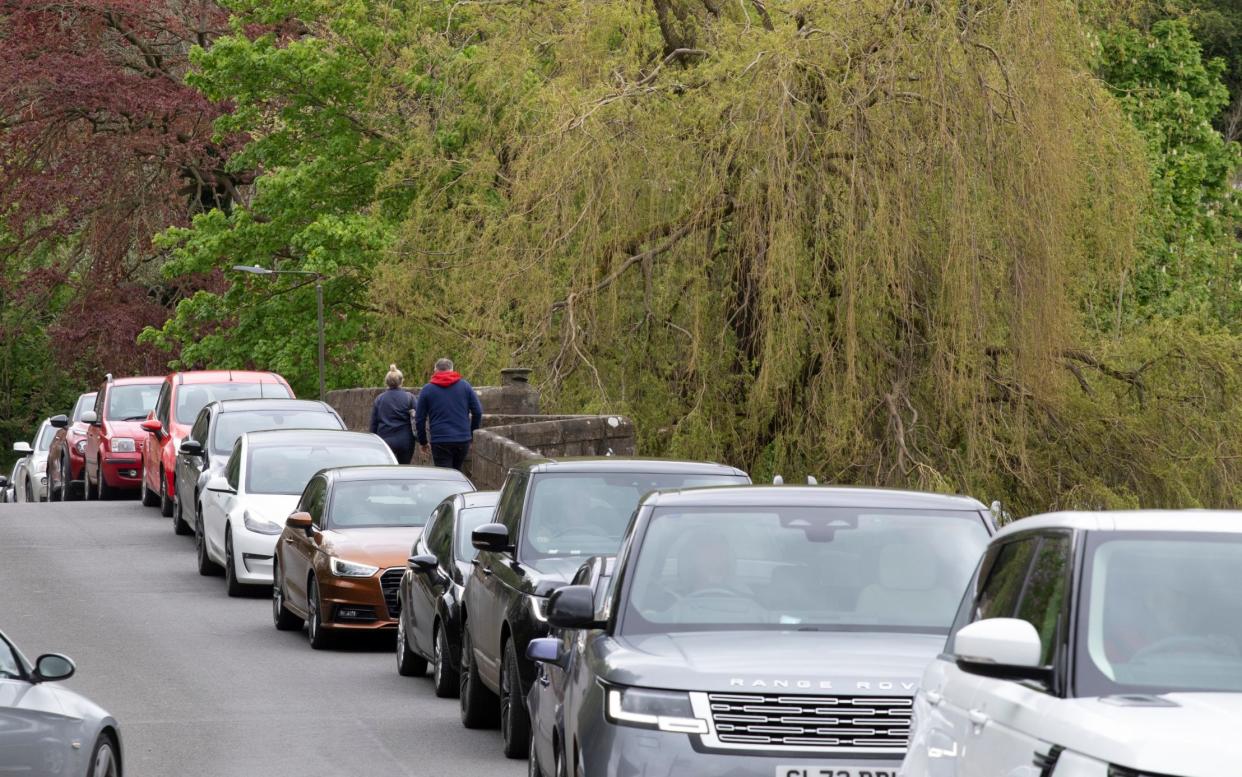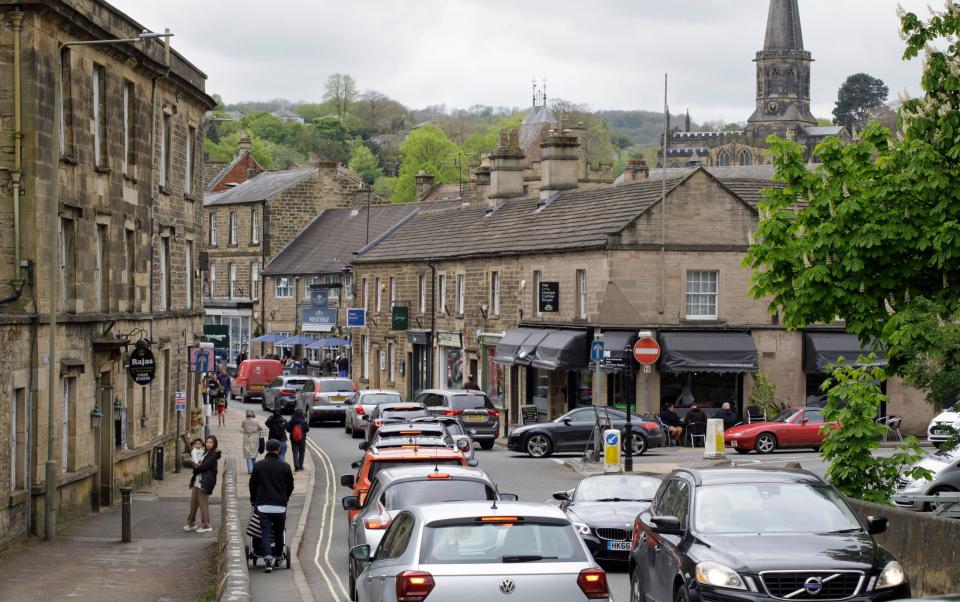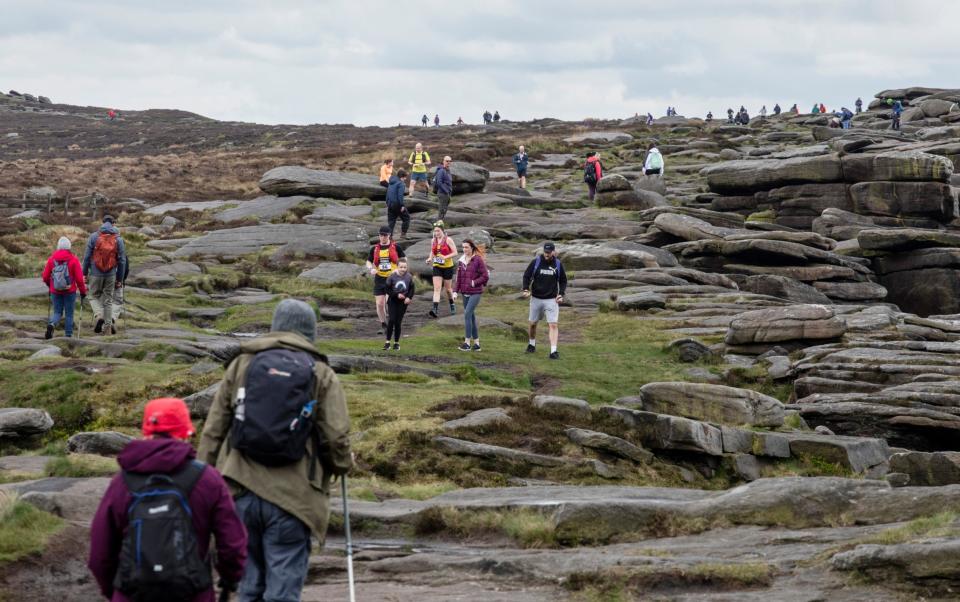Cars are spoiling Britain’s national parks – it’s time we embraced sustainable transport

What’s worse: a big grey tarmac car park, or vehicles lining every road as far as the eye can see? It’s the question I asked myself as I stood on the hillside of Winnats Head, overlooking the honeypot village of Castleton. It’s a marvellous view, albeit blighted by car-lined roads. A car park might make all the difference, but it would also be a blight on the landscape.
I’d spent the night before my journey into the Peak District at Mosborough Hall, a pleasant little hotel just south of Sheffield, the majority of whose guests tend to be on the way to the Peak District “for staycations focused on the area’s natural beauty”, explains the general manager Richard Beck. “In recent years, we’ve seen much younger guests. Walkers, climbers and cyclists, for example.” The car park was bulging by the time I checked in.
From there it was off to Bakewell, the Peak District’s best-known honeypot town, famed for its medieval bridge, sweet treats and proximity to Chatsworth House, which featured prominently in the 2005 adaptation of Pride And Prejudice. After a minor scrum to get into the main car park, I found the pretty town packed to the gills. On Water Street, home to a variety of cafés and gift shops, hordes of visitors crowded the lane, huge queues pouring out of every shop.
“It’s busy, but it’s not unusual for a bank holiday, it’s always like this,” my waitress shrugged, as I tucked into the town’s deservedly lauded speciality dish at The Old Original Bakewell Pudding Shop. “It keeps us in business. Anyone who wants to reduce the number of tourists would be out of work by the end of the month, even if they won’t admit it.”
However, for residents the picture isn’t quite as clear. Tourism in Bakewell is a “double-edged sword” says Judith Crosse, who lives locally and visits Bakewell frequently. She admits to feeling ambivalent about the way visitors affect the area. “The local economy depends so much on visitors, but I bought three books from the shop on Saturday and I was the best customer of the day. Tourism can be fickle like that. Bakewell in particular ‘suffers’ because it’s accessible from Manchester, Sheffield, Nottingham and Derby, plus it has the big pull of Chatsworth House on its doorstep.”

The bigger problem, Crosse thinks, is cars. “Generally people living within the Peak District think twice about going out on bank holidays due to the traffic,” she says. “I’ve turned around and gone home because of traffic more times than I could count. Even the secret rat runs that the locals know about get clogged up.”
I’m warned to avoid Ashbourne, a village to the south, at all costs, and Crosse says I’m lucky there’s no big events at Chatsworth this weekend as these would make life hell for drivers.
Things reached a nadir for the Peak District over the Easter Weekend, when a cyclist posted a video of the A6 grinding to a halt. A trip to Matlock? More like a trip to gridlock. As might be expected, the viral video brought about a broader conversation on how the “tourist industry has ruined every national park in the country”, according to one Facebook commenter.
Having visited a few national parks in recent months, pursuing stories of overtourism, I find that idea rather overblown. In my eyes, the Peak District seemed remarkably civilised. Piles of rubbish at Dovedale, crisp packets whipping around Kinder Scout’s peak, and used nappies littering paths around Ladybower Reservoir might make for clickable stories, but I found nothing of the sort.
Yes, there were plenty of people out exploring on the warm and pleasant Saturday afternoon. Yes, I found trails occasionally busy. But why not? Everyone I saw was enjoying the landscape safely and respectfully. I was impressed to see plenty of guidance on how to do so around the park, and there was no shortage of bins. Only a real stick-in-the-mud could possibly resent their fellow man for going out to enjoy the great outdoors.
The only issue I faced in the beautiful Peak District was the cars.
Research from car brand Dacia and parking website JustPark found that 21 million Britons – just over 40 per cent of drivers – were planning a road trip over the bank holiday weekend, with one in 10 saying it would likely be their only major road trip of the year. National parks like the Peak District face problems around the bank holidays for a reason. Tellingly though, 69 per cent of those surveyed cited the inability to find a parking space as one of their biggest concerns about making the trip.
In the Peak District, they’d have been right to worry. Everywhere I drove, vehicles lined the streets, on grassy verges by the side of roads festooned with vehicles. It made driving around the park fiddly and occasionally dangerous (the one bus I saw during my adventure was swinging wildly around a sharp corner to avoid parked cars on the side of the roads.)
“Make sure you write about the car parks,” moaned Sam, a student climber I met at Stanage Edge, a popular bouldering spot when I told him I was with The Telegraph. “The car park used to be free when we started coming up here a few years ago, but now they charge and so you end up with cars parked all over the roads.”

Parking policies are “inconsistent” across the national park, I was told. Some car parks require cash payment while others demand app payment (patchy countryside phone signals can make this tricky at the best of times.) “The park could definitely do more to advertise where car parks are, their capacity and how to pay in advance,” Allie, Sam’s partner, suggests.
Could parking be better? Possibly. Yet herein lies the Gordian knot which every national park must unpick: people come here to find an unspoilt natural landscape, but their presence is the thing spoiling it. Which brings us back to that question: car-lined roads or more car parks? Is there a lesser of two evils?
A simplistic analysis would suggest less cars entirely, but given 13.25 million people (and rising) visit the Peak District every year, and according to the National Park authority’s own stats, 85 per cent of them travel by car, it’s a fantasy.
The park is already served by five different railway lines and dozens of hourly buses; you’d be hard-pressed to argue that it is lacking in public transport links, especially compared to the likes of the Lake District or the Yorkshire Dales, which are far less well-served by railways. The truth is that driving is simply more convenient for most.
It’s not as if the national park is necessarily slouching on its responsibilities here either. Following a regional symposium with private and public sector stakeholders, it employed a sustainable travel officer whose job is to advise the five local authorities whose public transport serves the park to match visitor needs with services offered. The role also contains a commitment to promoting sustainable travel.
“We recognise that many visitors still choose to travel to the Peak District by car, which is why our own car park network continues to offer highly competitive fees, enabling people to park safely and considerately away from the roadside,” a Peak District National Park authority spokesperson told the Telegraph. “We continue to work closely with local transport authorities and private operators to understand the wider picture of travel to, and within, the Peak District so policies and services can meet expectations and relieve pressure in the most affected areas.”
What is to be done then? The answers are the same obvious suggestions every national park has been making for the past few years: we should all use public transport, we should clue ourselves up on the less-frequented areas, and we should plan our parking more carefully. And if you do find yourself facing a gridlock, try not to get angry – after all, you’re part of the problem.
Jack Rear was a guest of Mosborough Hall Hotel, which offers double rooms from £89.95 per night. A hire car was arranged by Dacia.

